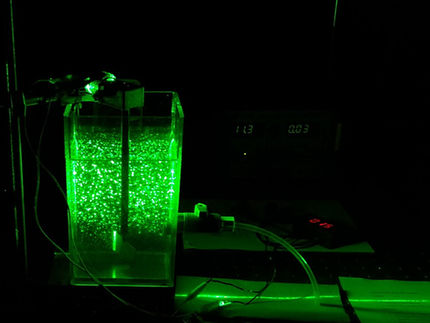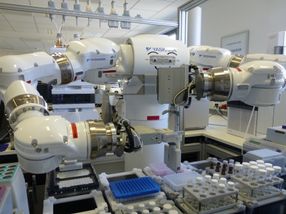New Argonne microscopy facility combines cutting-edge science, green architecture
The U.S. Department of Energy's (DOE) Argonne National Laboratory's recently completed Sub-Angstrom Microscopy and Microanalysis facility (SAMM) received a Federal water and Energy Management Award from DOE. The award – the only one given to a DOE national laboratory – recognized the efforts of Argonne's architects and engineers in designing a laboratory that was simultaneously scientifically cutting-edge and environmentally friendly.
The actual sub-angstrom microscope sits on a massive concrete island that must remain isolated from any vibrations in the surrounding environment. Because the resolution of the instrument is so fine – smaller that the diameter of a single atom – that the slightest disturbance could ruin an entire experiment.
To prevent this from happening, any external vibrations are serially dampened through a number of different materials so they do not affect the microscope. "It's the best building in the world for this type of science – that's what's most important," said Argonne architect George Norek. "I'm proud that we were recognized for our work to make it sustainable and energy efficient, but that would mean nothing if this building weren't up to snuff for research."
Scientific users and other architects have come from around the world to visit the SAMM facility to learn from its design. "If you take the right approach at the beginning, you can design a green building at no or very little additional cost," Norek said. He pointed to the laboratory's use of water conservation fixtures, preferred parking for carpools and high-efficiency vehicles, native landscaping and locally produced, recycled drywall as some of several measures that both held down cost and mitigated the facility's environmental impact. The laboratory has also submitted the SAMM facility for Leadership in Energy and Environmental Design (LEED) certification from the U.S. Green Building Council, and Norek expects the building to achieve LEED Gold certification.
Most read news
Other news from the department research and development

Get the analytics and lab tech industry in your inbox
By submitting this form you agree that LUMITOS AG will send you the newsletter(s) selected above by email. Your data will not be passed on to third parties. Your data will be stored and processed in accordance with our data protection regulations. LUMITOS may contact you by email for the purpose of advertising or market and opinion surveys. You can revoke your consent at any time without giving reasons to LUMITOS AG, Ernst-Augustin-Str. 2, 12489 Berlin, Germany or by e-mail at revoke@lumitos.com with effect for the future. In addition, each email contains a link to unsubscribe from the corresponding newsletter.






















































